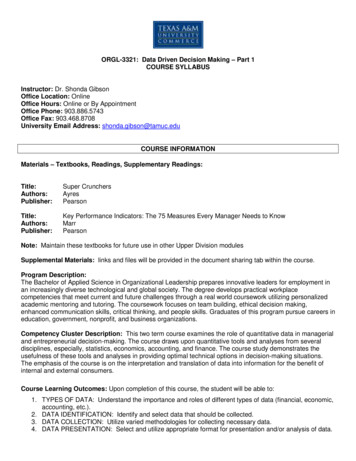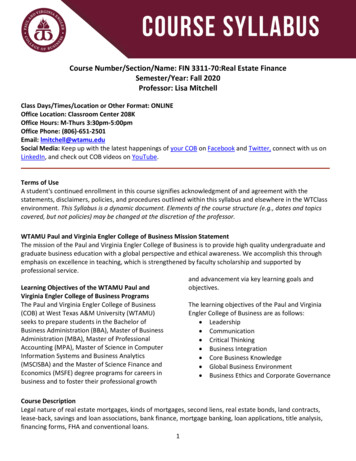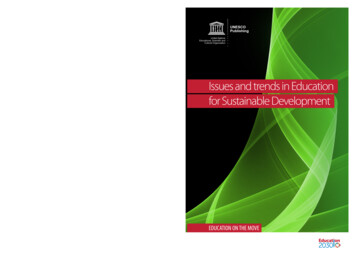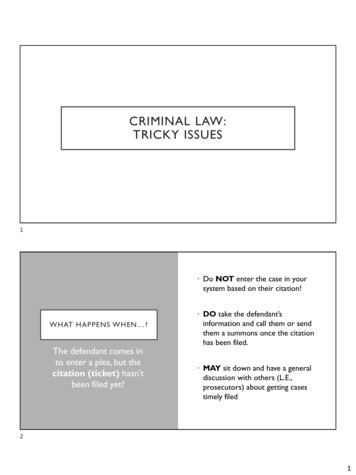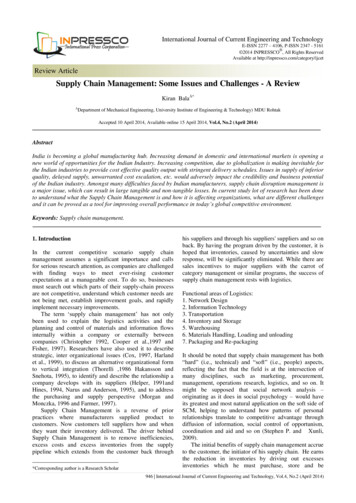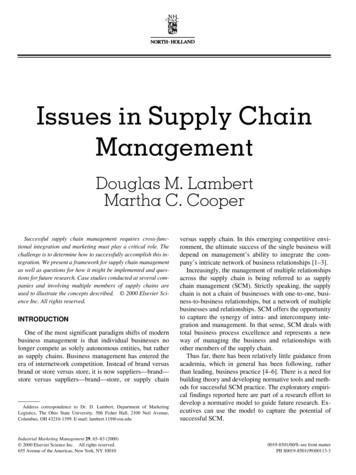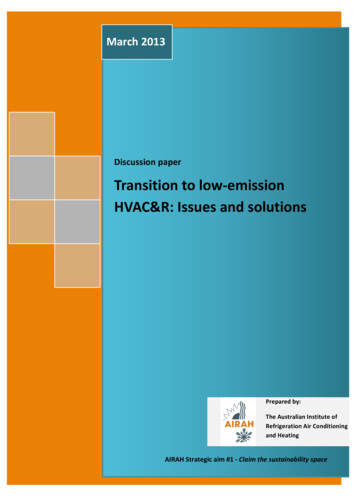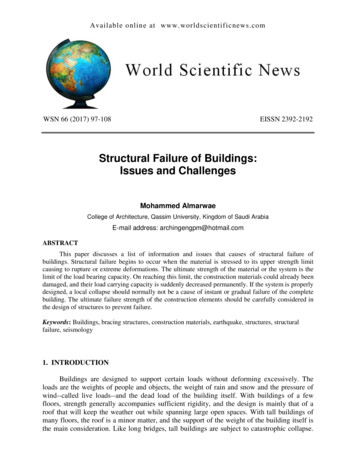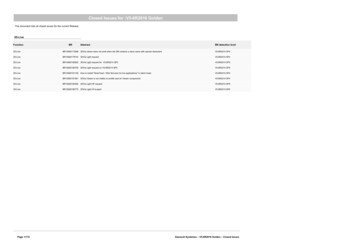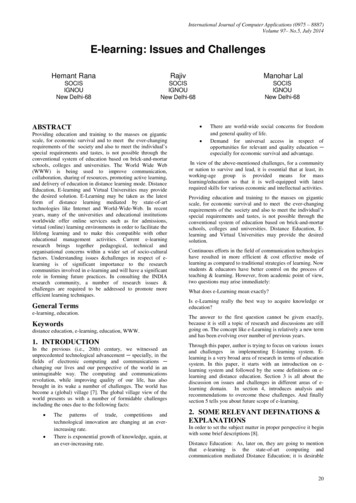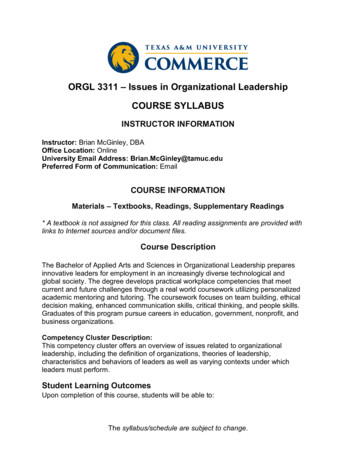
Transcription
ORGL 3311 – Issues in Organizational LeadershipCOURSE SYLLABUSINSTRUCTOR INFORMATIONInstructor: Brian McGinley, DBAOffice Location: OnlineUniversity Email Address: Brian.McGinley@tamuc.eduPreferred Form of Communication: EmailCOURSE INFORMATIONMaterials – Textbooks, Readings, Supplementary Readings* A textbook is not assigned for this class. All reading assignments are provided withlinks to Internet sources and/or document files.Course DescriptionThe Bachelor of Applied Arts and Sciences in Organizational Leadership preparesinnovative leaders for employment in an increasingly diverse technological andglobal society. The degree develops practical workplace competencies that meetcurrent and future challenges through a real world coursework utilizing personalizedacademic mentoring and tutoring. The coursework focuses on team building, ethicaldecision making, enhanced communication skills, critical thinking, and people skills.Graduates of this program pursue careers in education, government, nonprofit, andbusiness organizations.Competency Cluster Description:This competency cluster offers an overview of issues related to organizationalleadership, including the definition of organizations, theories of leadership,characteristics and behaviors of leaders as well as varying contexts under whichleaders must perform.Student Learning OutcomesUpon completion of this course, students will be able to:The syllabus/schedule are subject to change.
1. Define organization, leadership, and distinguish the difference betweenleadership and management within an organization.2. Explain fundamental theories of leadership and recognize situations in which thetheories are applied.3. Demonstrate awareness of legal, personnel, and strategic issues relating toglobalization, culture and gender diversity in an organization and their influenceon organizational leadership.4. Examine issues relating to communication in an organization and discussstrategies for becoming an effective and ethical communicator.5. Explain the importance of teams in organizations and evaluate leader influenceson building high-performance teams.6. Examine conflict resolution strategies, the role of conflict, and negotiations.COURSE REQUIREMENTSPretestThe purpose of the pretest is to provide a baseline understanding of your knowledgerelative to this competency. The pretest is required before you begin studying coursematerials. The Pretest for this course assesses your current knowledge of issues inorganizational leadership, including the definition of organizations, theories ofleadership, and characteristics and behaviors of leaders in various contexts.Posttest and Culminating ProjectThe Posttest and Culminating Project for this course assess your culminatingknowledge of issues in organizational leadership, including the definition oforganizations, theories of leadership, and characteristics and behaviors of leaders invarious contexts.A score of 80 percent or higher on both the Posttest and Culminating Project isrequired to demonstrate competency.If you score less than 80 percent on the Posttest and/or Culminating Project you willhave an opportunity to review the course materials and re-take the Posttest and/orresubmit the Culminating Project. You may take the Posttest assessment and submitthe Culminating Project up to three times during the seven-week term. Please avoidthe last minute submission if you expect/plan to revise your work. Project grading cantake up to 2 3 days – revision and timely grading during the last minute can be risky.TECHNOLOGY REQUIREMENTSBrowser supportD2L is committed to performing key application testing when new browser versions arereleased. New and updated functionality is also tested against the latest version ofsupported browsers. However, due to the frequency of some browser releases, D2LThe syllabus/schedule are subject to change.
cannot guarantee that each browser version will perform as expected. If you encounterany issues with any of the browser versions listed in the tables below, contact D2LSupport, who will determine the best course of action for resolution. Reported issuesare prioritized by supported browsers and then maintenance browsers.Supported browsers are the latest or most recent browser versions that are testedagainst new versions of D2L products. Customers can report problems and receivesupport for issues. For an optimal experience, D2L recommends usingsupported browsers with D2L products.Maintenance browsers are older browser versions that are not tested extensivelyagainst new versions of D2L products. Customers can still report problems and receivesupport for critical issues; however, D2L does not guarantee all issues will beaddressed. A maintenance browser becomes officially unsupported after one year.Note the following: Ensure that your browser has JavaScript and Cookies enabled.For desktop systems, you must have Adobe Flash Player 10.1 or greater.The Brightspace Support features are now optimized for productionenvironments when using the Google Chrome browser, Apple Safari browser,Microsoft Edge browser, Microsoft Internet Explorer browser, and MozillaFirefox browsers.Desktop SupportBrowserSupported Browser Version(s) Maintenance Browser Version(s)Microsoft EdgeLatestN/AMicrosoft InternetExplorer N/A11Mozilla Firefox Latest, ESRN/AGoogle Chrome LatestN/AApple Safari LatestN/AThe syllabus/schedule are subject to change.
Tablet and Mobile SupportDeviceOperatingSystemBrowserSupported Browser Version(s)Android Android 4.4 ChromeLatestAppleiOS Safari,ChromeThe current major version ofiOS (the latest minor or pointrelease of that major version)and the previous major versionof iOS (the latest minoror point release of that majorversion). For example, as ofJune 7, 2017, D2Lsupports iOS10.3.2 and iOS 9.3.5, but notiOS 10.2.1, 9.0.2, or any otherversion.Chrome: Latest version for theiOS browser.WindowsWindows 10Edge,Chrome,FirefoxLatest of all browsers, andFirefox ESR. You will need regular access to a computer with a broadband Internet connection.The minimum computer requirements are:o 512 MB of RAM, 1 GB or more preferredo Broadband connection required courses are heavily video intensiveo Video display capable of high-color 16-bit display 1024 x 768 or higherresolution You must have a:o Sound card, which is usually integrated into your desktop or laptopcomputero Speakers or headphones.o *For courses utilizing video-conferencing tools and/or an online proctoringsolution, a webcam and microphone are required. Both versions of Java (32 bit and 64 bit) must be installed and up to date on yourmachine. At a minimum Java 7, update 51, is required to support the learningmanagement system. The most current version of Java can be downloaded at:JAVA web site http://www.java.com/en/download/manual.jsp Current anti-virus software must be installed and kept up to date.The syllabus/schedule are subject to change.
Running the browser check will ensure your internet browser is supported.Pop-ups are allowed.JavaScript is enabled.Cookies are enabled. You will need some additional free software (plug-ins) for enhanced web browsing.Ensure that you download the free versions of the following software:o Adobe Reader https://get.adobe.com/reader/o Adobe Flash Player (version 17 or later) https://get.adobe.com/flashplayer/o Adobe Shockwave Player https://get.adobe.com/shockwave/o Apple Quick Time http://www.apple.com/quicktime/download/ At a minimum, you must have Microsoft Office 2013, 2010, 2007 or Open Office.Microsoft Office is the standard office productivity software utilized by faculty,students, and staff. Microsoft Word is the standard word processing software,Microsoft Excel is the standard spreadsheet software, and Microsoft PowerPoint isthe standard presentation software. Copying and pasting, along withattaching/uploading documents for assignment submission, will also be required. Ifyou do not have Microsoft Office, you can check with the bookstore to see if theyhave any student copies.ACCESS AND NAVIGATIONYou will need your campus-wide ID (CWID) and password to log into the course. If youdo not know your CWID or have forgotten your password, contact the Center for ITExcellence (CITE) at 903.468.6000 or helpdesk@tamuc.edu.Note: Personal computer and internet connection problems do not excuse therequirement to complete all course work in a timely and satisfactory manner. Eachstudent needs to have a backup method to deal with these inevitable problems. Thesemethods might include the availability of a backup PC at home or work, the temporaryuse of a computer at a friend's home, the local library, office service companies,Starbucks, a TAMUC campus open computer lab, etc.COMMUNICATION AND SUPPORTBrightspace SupportNeed Help?Student SupportIf you have any questions or are having difficulties with the course material, pleasecontact your Instructor.The syllabus/schedule are subject to change.
Technical SupportIf you are having technical difficulty with any part of Brightspace,please contact Brightspace Technical Support at 1-877-325-7778or click on the Live Chat or click on the words “click here” tosubmit an issue via email.System MaintenancePlease note that on the 4th Sunday of each month there will be System Maintenancewhich means the system will not be available 12 pm-6 am CST.Interaction with Instructor StatementEmail in the best way to contact the instructor. Course shell also provides a way toshare content related questions and help needs through multiple discussion forums. Ifthe instructor cannot be reached during office hours and talking over the phone ishelpful, leaving a voice mail or emailing the instructor leaving the best date, time, andphone number to reach will be most effective.COURSE AND UNIVERSITY PROCEDURES/POLICIESCourse Specific Procedures/PoliciesThe instructor will make every effort to grade an exam and the final project in time. If anunusual delay should occur, such as illness or a conference travel, instructor availabilityand expected timeline/response will be shared as course announcement in the courseshell. The course has no extra-credit assignment.Syllabus Change PolicyThe syllabus is a guide. Circumstances and events, such as student progress, maymake it necessary for the instructor to modify the syllabus during the semester. Anychanges made to the syllabus will be announced in advance.University Specific ProceduresStudent ConductAll students enrolled at the University shall follow the tenets of common decency andacceptable behavior conducive to a positive learning environment. The Code ofStudent Conduct is described in detail in the Student he syllabus/schedule are subject to change.
Students should also consult the Rules of Netiquette for more information regardinghow to interact with students in an online forum: es.htmlTAMUC AttendanceFor more information about the attendance policy please visit the Attendance webpageand Procedure 99.R0.01.pdfAcademic IntegrityStudents at Texas A&M University-Commerce are expected to maintain high standardsof integrity and honesty in all of their scholastic work. For more details and thedefinition of academic dishonesty see the following procedures:Undergraduate Academic Dishonesty AcademicDishonesty.pdfGraduate Student Academic Dishonesty emicDishonesty.pdfADA StatementStudents with DisabilitiesThe Americans with Disabilities Act (ADA) is a federal anti-discrimination statute thatprovides comprehensive civil rights protection for persons with disabilities. Among otherthings, this legislation requires that all students with disabilities be guaranteed alearning environment that provides for reasonable accommodation of their disabilities. Ifyou have a disability requiring an accommodation, please contact:Office of Student Disability Resources and ServicesTexas A&M University-CommerceGee Library- Room 162Phone (903) 886-5150 or (903) 886-5835Fax (903) 468-8148Email: studentdisabilityservices@tamuc.eduThe syllabus/schedule are subject to change.
Website: Office of Student Disability Resources and rimination NoticeTexas A&M University-Commerce will comply in the classroom, and in online courses,with all federal and state laws prohibiting discrimination and related retaliation on thebasis of race, color, religion, sex, national origin, disability, age, genetic information orveteran status. Further, an environment free from discrimination on the basis of sexualorientation, gender identity, or gender expression will be maintained.Campus Concealed Carry StatementTexas Senate Bill - 11 (Government Code 411.2031, et al.) authorizes the carrying of aconcealed handgun in Texas A&M University-Commerce buildings only by persons whohave been issued and are in possession of a Texas License to Carry a Handgun.Qualified law enforcement officers or those who are otherwise authorized to carry aconcealed handgun in the State of Texas are also permitted to do so. Pursuant to PenalCode (PC) 46.035 and A&M-Commerce Rule 34.06.02.R1, license holders may notcarry a concealed handgun in restricted locations.For a list of locations, please refer to the Carrying Concealed Handguns On Campusdocument and/or consult your event organizer.Web loyeesAndStudents/34.06.02.R1.pdfPursuant to PC 46.035, the open carrying of handguns is prohibited on all A&MCommerce campuses. Report violations to the University Police Department at 903886-5868 or 9-1-1.COURSE OUTLINE / CALENDARLearning Outcome and Materials toReviewNO REVIEW NEEDEDContentPRETEST: COMPLETE ON FIRSTDAYThe syllabus/schedule are subject to change.
LO1. Define organization, leadership, anddistinguish the difference betweenleadership and management within anorganization:Overview of OrganizationalLeadership, Major Coursework, andIssues in Organizational Leadership Defining an Organization Defining Leadership Organizational Leadership Differences between leadership andmanagement in organizationsLO2. Explain fundamental theories ofleadership and recognize situations inwhich the theories are applied:DiscussionQuiz DiscussionQuizIntroduction to Leadership Theories of Leadershipo Leadership Traitso Leadership Skillso Leadership StylesLO3. Demonstrate awareness of legal,personnel, and strategic issues relating to Discussionglobalization, culture and gender diversity Quizin an organization and their influence onorganizational leadership: Effective Global Leadership Leadership and Culture Leadership and GenderLO4. Examine issues relating tocommunication in an organization anddiscuss strategies for becoming aneffective and ethical communicator: DiscussionQuizCommunication ProcessBarriers to Effective CommunicationActive ListeningNonverbal and Body LanguageEthical CommunicationThe syllabus/schedule are subject to change.
LO5. Explain the importance of teams inorganizations and evaluate leaderinfluences on building high-performanceteams:Difference Between “Group” and “Team” Stages of Team Development Leading, Empowering, FollowingLO6. Examine conflict resolutionstrategies, the role of conflict, andnegotiations:DiscussionQuiz Levels of ConflictConflict Resolution Stimulating Constructive IntergroupConflict Negotiations and TacticsREVIEW ALL NECESSARY MATERIALSDiscussionQuiz PROJECT(S)POSTTEST: COMPLETEBEFORE FINAL DAY1. ManeSync Assignment2. Leadership Video Assignment3. Project: Personal LeadershipPlan - SUBMIT BEFORE FINALDAY (Activities Assignment Project Dropbox).The syllabus/schedule are subject to change.
leadership and management within an organization. 2. Explain fundamental theories of leadership and recognize situations in which the theories are applied. 3. Demonstrate awareness of legal, personnel, and strategic issues relating to globalization, culture and gender diversity in an organization and their influence on organizational leadership. 4.
